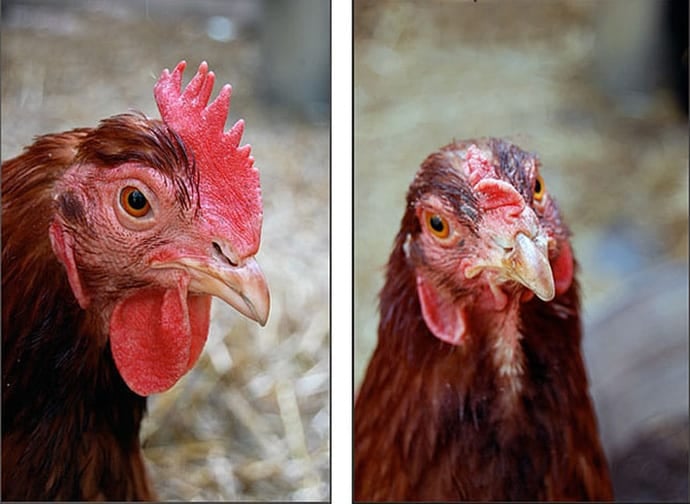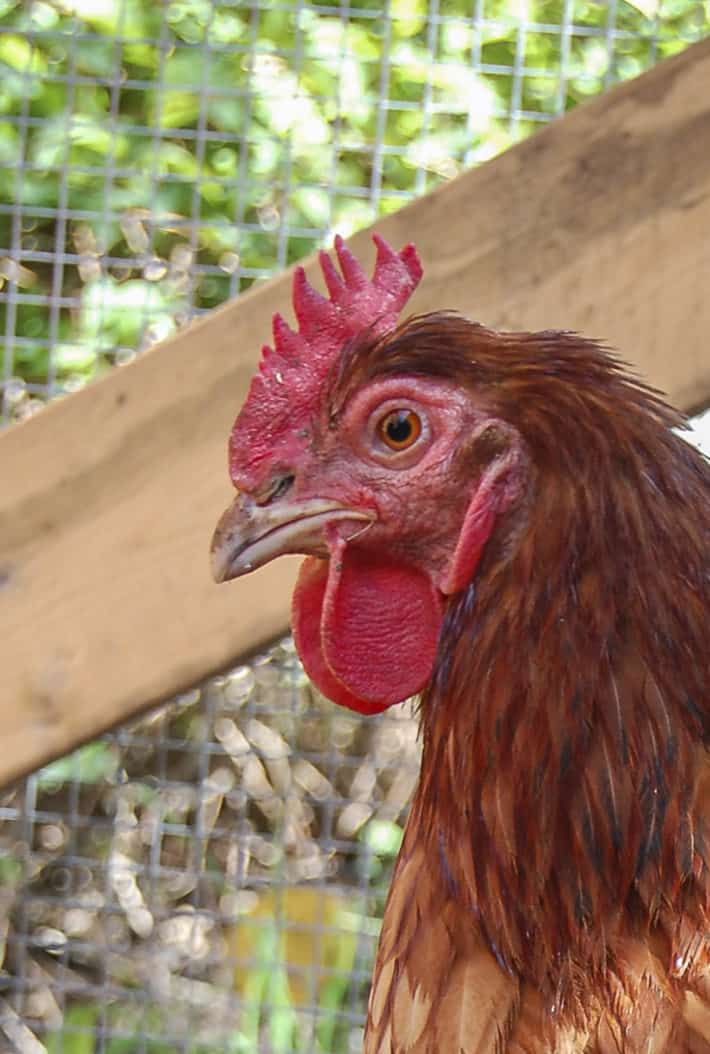The anatomy of a chicken is one of the first things you should learn about your hens when you first get them. Youll understand your birds better and when someone points to something weird on it and asks “Whats that??” youll know the answer.
A few days ago 2 neighbour kids came to my door asking me where they could get a chick. One chick. They thought they could trade it with each other and also thought that I would know where to get something like that.
Sadly for the girls I had to inform them that chickens are social animals and one little chick was likely to die of loneliness. They were quite distraught over this bit of news but accepted it.
They are fun, they are cute, they are entertaining, but chickens are also, weird, complicated living creatures not unlike men. Or sourdough starter.
If youre going to have chickens, you should know a few things about their unique physical features.
Chickens are a common domesticated bird that most people know about. But if you want to learn more about how chickens work and what they look like, this article will cover everything you need to know.
Chicken Size and Shape
They come in many breeds and sizes, but most of them have a round, compact body. Bantam breeds are very small, weighing only 1-2 pounds, while meat and show breeds are big, weighing 8–15 pounds.
On average a standard chicken is about 9-12 inches tall when standing upright. Their bodies are plump and rounded, with a short neck and small head proportional to their body size. Chickens have a wattled head and comb which is a fleshy red appendage on top of their head.
Feathers and Plumage
A chicken’s body is completely covered in feathers. For warmth, they have soft, fluffy down feathers close to their skin. They have soft down feathers on top of which are stiffer, glossier contour feathers that cover the rest of the body in a smooth layer.
Chicken feathers come in many colors and patterns depending on the breed. Common feather colors are white, black, brown, red, and golden. The rooster or male chicken often has more ornate, colorful plumage than the hen.
The tail feathers of a rooster are especially long and arching, forming a sickle shape. Hens have shorter, rounded tails. The neck and saddle feathers (back area) of a rooster are pointed and flowy. Hens have neatly arranged, close-fitting neck and back feathers.
Legs and Feet
Chickens stand on two slender yellow or white legs. They have four clawed toes on each foot, three that point forward and one that points back. This arrangement of toes is called anisodactyl. The claws are short, blunt, and curved so they can scratch and grab things.
Most breeds do not have feathers on their lower legs and feet. The shanks (lower legs) have scales, similar to the texture of reptile skin. Some breeds have feathers growing on the shanks and toes as well.
Head and Beak
Chickens have a small head on a S-shaped neck. The beak is short, pointed, and tan or yellow colored. The beak shape allows chickens to peck, grasp, and break down food items.
On top of the head is a fleshy red comb. Under the chin are red wattles dangling from each side of the head. The comb and wattles are more prominent on roosters than hens. They play a role in thermoregulation and mating displays.
Wings
The wings are small and rounded, with feathers closely molded to the body when folded. Chickens are not the strongest flyers, so their wings are built for short bouts of flight to get them off the ground.
The long flight feathers at the end of the wing create a fan shape. The flight feathers are typically a different color than the body feathers, like white, black, or iridescent.
Tail
The tail shape and size varies between hens and roosters. Roosters have a long, arching tail made of sickle-shaped feathers that can measure over a foot long in some breeds. Hens have a short, rounded, fan-shaped tail.
The tail feathers overlay each other neatly. They are used for balance, steering, and signaling, as well as courtship displays in roosters. Mature roosters grow elaborate, decorative tail covert feathers along with the sickle feathers.
Internal Anatomy
-
Skeletal system – Chickens have a lightweight skeleton with hollow bones. The number of bones varies between breeds.
-
Muscular system – The pectoral muscles power the wings for flight. Leg muscles control scratching, walking, and kicking.
-
Respiratory system – Air sacs throughout the body facilitate breathing. Lungs are small and rigid.
-
Circulatory system – The heart has 4 chambers to pump blood. Arteries bring blood from heart to tissues.
-
Digestive system – Crop stores and softens food. Gizzard grinds food. Intestines extract nutrients.
-
Reproductive system – Hens have only one functional ovary. Roosters have internal testes.
Behavior and Senses
Chickens have distinct behaviors and specialized senses that allow them to navigate the world:
-
Vision – Excellent daytime vision but poor night vision. Can detect movement and colors.
-
Hearing – Able to detect sounds at lower and higher frequencies than humans.
-
Taste – Can taste saltiness, sweetness, sourness, and bitterness. Important for diet choices.
-
Scent – Nostrils can detect odors and chemical cues. Scent guides social behavior.
-
Pecking – Use strong beak to peck at food, dirt, and objects. Explore surroundings.
-
Scratching – Use feet to scratch ground to dig up insects and seeds to eat.
-
Dust bathing – Coat feathers in dust to clean them and deter parasites. Social activity.
In Summary
From their compact, rounded bodies covered in layered feathers, to their clawed feet and small beaks, chickens have distinctive physical features that equip them for life as ground-dwelling birds. Their appearance can vary among the numerous breeds, but all chickens share characteristic anatomy like wattles, combs, wings, and tails that give them their archetypal chicken look.

Chicken Combs – the blob on their head/beak
There are a whack of different chicken combs including the single comb, buttercup comb, strawberry comb, rose comb and pea comb.
The breeds I have had have either topped their heads with a single comb or a pea comb so well look at those.
As an aside, I find combs to be moderately repulsive. Perhaps it has something to do with the fact that theyre an organ. You know, like a kidney or a heart.
The chickens comb is considered an organ because it has such a vital function. With no sweat glands, chickens regulate their body temperature through their combs.

Norma (Rhode Island Red) with her single comb. Cuddles (mixed breed) with her pea comb.
Single comb – Single combs are the most common. Theyre a series of spikes that run from the chickens beak to the back of their head.
Pea comb – Pea combs are a series of small, short bumps. It can be a single row of bumps, or 3 rows side by side.
Single Combs are dominant in Rhode Island Reds and Pea Combs are often seen in Ameraucana or Araucanas.
A grown chickens comb should be red. If it isnt, and looks pale, you have an unwell chicken.
CHICKEN HEALTH
A pale chicken comb could be a sign of any of these conditions:
- internal parasites (too many worms in them)
- mites
- heat exhaustion
- moulting
Of all those things the only thing you dont have to worry about is moulting. If your chicken doesn’t shed feathers or moult but has a pale comb, something is wrong and you need to figure it out.
Chicken Wattles – the dangly bits below the beak
Just like combs, wattles come in a ranges of sizes from almost non existent to huge, flappy things.

Wattles arent just for laughing at. Blood flow from the comb to the wattle is what helps regulate the chickens temperature to keep it cool in the heat.
Muffs (around the cheeks) and beards (on the front of the neck) dont seem to have any cool purpose or super-power. Theyre like press on nails; theyre just decorative.

Baby has a beard.
Pure-bred Ameraucanas and sometimes Ameraucana crosses like Olive Eggers and Easter Eggers have muffs and beards.
How is a chicken egg made? #education #knowledge #viral
FAQ
What does the chicken look like?
Chickens are average-sized fowls, characterized by smaller heads, short beaks and wings, and a round body perched on featherless legs. Exact size varies greatly among breeds, as does color. In many breeds, both sexes will have fleshy skin folds on the chin and atop the head, known as wattles and combs, respectively.
What does the original chicken look like?
Because they look so much alike, Charles Darwin thought that chickens came from the red jungle fowl, a colorful tropical bird in the pheasant family.
What two birds made a chicken?
The chicken was first tamed from red junglefowl. Later, genes from grey junglefowl, Sri Lankan junglefowl, and green junglefowl were added.
How many holes do female chickens have?
Understanding the Cloaca: Unlike humans and most mammals, a female chicken has but one rear orifice with three functions. It is where feces and eggs exit her body and sperm enter.
